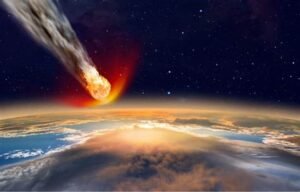
Astronomers have eased global concerns by announcing that asteroid 2024 YR4, once labeled a “city-killer,” will not strike Earth in December 2032. This space rock, discovered in late 2024, initially created panic when early calculations suggested a 3.1% chance of impact. Scientists now confirm that the likelihood has dropped dramatically to just 0.0017%, allowing the world to breathe a collective sigh of relief.
A Terrifying Start
The journey of asteroid 2024 YR4 into the public eye began with a routine sky survey in December 2024. Astronomers using ground-based telescopes noticed a previously undetected object hurtling through space. As they tracked its orbit, researchers noticed an alarming trend: the asteroid’s projected path intersected with Earth’s orbit in December 2032.
The media quickly picked up the story, labeling it a “city-killer” due to its size and destructive potential. Measuring approximately 320 meters in diameter—larger than the Eiffel Tower—2024 YR4 carried enough mass to cause catastrophic damage to any urban area it might strike. Scientists estimated that an impact would unleash energy equal to several thousand megatons of TNT, flattening buildings, starting fires, and potentially causing thousands or even millions of deaths.
Governments and space agencies rushed to gather more data, while the public reacted with a mix of fear, fascination, and disbelief. The asteroid suddenly became a household name, sparking widespread discussions about Earth’s vulnerability to space hazards.
New Observations Paint a Different Picture
In early 2025, astronomers expanded their observation efforts. Observatories around the world, including the European Southern Observatory, NASA’s Jet Propulsion Laboratory, and independent space researchers, focused their attention on 2024 YR4. Using radar imaging, deep-space telescopes, and updated trajectory modeling, they collected weeks of new data.
Their improved calculations revealed a different outcome. The asteroid would pass Earth at a safe distance of several million kilometers. The initial estimate of a 3.1% impact probability came from limited observations and lacked the precision necessary for accurate prediction. As the tracking window expanded, the calculations improved.
NASA’s Center for Near-Earth Object Studies confirmed the update on March 25, 2025, just two days before the news reached the public. Scientists removed 2024 YR4 from the Sentry Risk Table, which lists objects with the potential to hit Earth. Planetary defense experts declared that the asteroid posed no significant threat in the foreseeable future.
Jupiter’s Role in Changing the Outcome
Researchers credited the gravitational influence of Jupiter for altering the asteroid’s path. The gas giant, which often acts as a solar system guardian, once again played a crucial role in Earth’s safety.
Jupiter’s immense gravity exerts powerful effects on nearby objects. In the case of 2024 YR4, the asteroid passed close enough to Jupiter in early 2025 to experience a slight change in trajectory. That minor shift significantly affected its path toward Earth, pushing it just far enough to miss our planet completely.
Planetary scientists continue to study Jupiter’s role in protecting Earth. Time and again, the planet has pulled potential threats off collision courses, acting as a massive space shield. The recent events involving 2024 YR4 reinforce this protective role.
Public Reaction and Relief
After the initial panic, the updated news brought relief to governments, space agencies, and the public. In cities around the globe, news outlets shifted the tone of their coverage from anxiety to admiration for the astronomers who averted the false alarm through scientific diligence.
Social media reacted quickly. Memes, jokes, and expressions of relief flooded platforms like X (formerly Twitter), Instagram, and Reddit. One popular meme featured a photoshopped image of Jupiter with the caption, “Thanks for having our backs… again.”
Public interest in planetary defense surged. Online searches for terms like “asteroid monitoring,” “NASA DART mission,” and “planetary defense strategies” spiked overnight. Educational institutions reported increased engagement in astronomy clubs and science programs.
Calls for Better Preparedness
Although scientists ruled out a collision with 2024 YR4, they did not dismiss the broader threat of near-Earth objects (NEOs). Space agencies around the world renewed calls for investment in planetary defense infrastructure.
NASA’s Planetary Defense Coordination Office emphasized the importance of continued vigilance. “This close call reminds us that we need robust detection and deflection strategies,” said Lindley Johnson, a key official in the program.
The European Space Agency (ESA) echoed this sentiment. They called for funding expansions for their “Hera” mission, which will study the results of NASA’s 2022 DART mission and explore how to prevent future impacts. Governments in Asia, Europe, and the Americas discussed new international agreements for space threat mitigation.
China’s National Space Administration proposed a new early-warning system that combines satellite monitoring with AI-driven prediction algorithms. India’s ISRO announced plans to host an international workshop later in 2025, inviting experts from across the globe to discuss asteroid impact preparedness.
The Next Potential Threat?
Despite the positive outcome regarding 2024 YR4, astronomers continue to monitor thousands of NEOs. Some space objects remain uncharted due to their small size or irregular orbits. Researchers say Earth avoids dangerous impacts only through luck and improved surveillance.
Scientists have already flagged other objects that deserve attention. Asteroid 2005 ED224 and 1999 AN10 both have close flybys scheduled over the next few decades. Although these objects currently pose no imminent threat, astronomers will track their orbits continuously to detect any anomalies.
Meanwhile, agencies like NASA and ESA work on advanced missions to improve deflection technology. The success of the 2022 DART mission—where NASA successfully altered the orbit of a small asteroid by crashing a spacecraft into it—proves that humanity can develop solutions to defend the planet.
The Bigger Picture: Vigilance, Science, and Global Unity
The 2024 YR4 incident reminds the world of the fragile balance Earth maintains within the cosmic landscape. Space remains full of unpredictable forces, and modern life depends on the vigilance of scientists and astronomers.
In the face of a potential doomsday scenario, humanity turned to science. Researchers used mathematics, telescopes, and simulations—not guesswork—to reach a solution. Their dedication and collaboration across continents averted unnecessary panic and demonstrated the power of global scientific cooperation.
As Earth continues its journey around the sun, threats may come and go. But with eyes on the sky and minds committed to discovery, humanity holds the tools to predict, prepare, and protect itself.
The story of 2024 YR4 ends not in fire and destruction, but in relief, gratitude, and renewed determination. And somewhere in the vastness of space, Jupiter continues its quiet watch, helping to keep Earth just a little safer.
ALSO READ: Alysa Liu Stuns at World Figure Skating Championships






